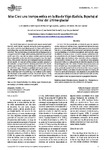Islas Cíes: una trampa eólica en la Ría de Vigo (Galicia, España) al final del último glaciar

Use this link to cite
http://hdl.handle.net/2183/38384
Except where otherwise noted, this item's license is described as Creative Commons Attribution-NonCommercial-ShareAlike 4.0 International License (CC BY-NC-SA 4.0)
Collections
- Investigación (FCIE) [1228]
Metadata
Show full item recordTitle
Islas Cíes: una trampa eólica en la Ría de Vigo (Galicia, España) al final del último glaciarAlternative Title(s)
Cíes Islands: a wind trap in the Ria of Vigo (Galicia, Spain) at the end of the Last GlacialDate
2021Citation
Arce Chamorro, C., Vidal Romaní, J. R., & Sanjurjo Sánchez, J. (2021). Islas Cíes: Una trampa eólica en la ría de vigo (galicia, españa) al final del último glaciar. Geogaceta, 70, 3-6.
Abstract
[Resumen] Las Islas Cíes han constituido un obstáculo para los intensos
vientos costeros del Atlántico Norte, especialmente durante las fases
glaciares del Cuaternario. Al final del último glaciar el mar descendió
más de 100 m por debajo de su nivel actual. Este descenso transformó el archipiélago en un relieve emergido de 300 m de alto, capaz
de deflectar el viento y atraer, al mismo tiempo, sedimentos eólicos procedentes de una franja de plataforma continental también
emergida. Bajo esta hipótesis, estos materiales eólicos se depositaron cubriendo el contorno de Cíes. Un ejemplo de estos episodios
de acreción eólica es el afloramiento de eolianitas situado en la Isla
de Monteagudo (Islas Cíes, Galicia, España), interpretado como una
duna rampante que estuvo activa desde el final del Pleistoceno Superior, cubriendo parcialmente la vertiente oriental. Con un espesor
de más de 3 metros y una edad (OSL) de 35 ka (b2k) en el muro y de
17 ka en el techo de la formación, este depósito es una prueba de la
eolización desarrollada en la costa de Galicia durante miles de años,
interrumpida al cesar los aportes durante el postglaciar holoceno. [Abstract] Cies Islands have been an obstacle to the intense coastal winds
from the North Atlantic, especially during the Quaternary glacial cycles. At the end of the Last Glacial period, the local sedimentary-record shows that sea-level decreased more than 100 m below present level. This sea-level drop transformed the archipelago into an
emerged relief 300 m high, which probably deflected the wind and,
at the same time, was able to capture aeolian sediments coming
from a strip of the continental shelf also emerged. Under this hypothesis, these aeolian materials were deposited covering the contour
of Cies Islands. An example of these aeolian accretion processes is
the eolianites outcrop located at Monteagudo Island (Cies Islands,
Galicia, Spain) interpreted as a climbing-dune which was active from
the end of the Upper Pleistocene, partially covering the eastern slope. This deposit more than 3 meters thick with an OSL age of 35 ky
(b2k) at the base and 17 ky at the top, is an evidence of the aeolisation developed in the Galician coast for thousands of years, finally
disrupted when aeolian-supplies were suspended during Holocene
post-glacial.
Keywords
Eolianitas costeras
Datación OSL
Pleistoceno Superior
Glacioeustasia
Islas Cíes, Galicia (N.O. de España)
Coastal eolianites
OSL-dating
Upper Pleistocene; glacio-eustasy
Cies Islands, Galicia (NW of Spain)
Datación OSL
Pleistoceno Superior
Glacioeustasia
Islas Cíes, Galicia (N.O. de España)
Coastal eolianites
OSL-dating
Upper Pleistocene; glacio-eustasy
Cies Islands, Galicia (NW of Spain)
Rights
Creative Commons Attribution-NonCommercial-ShareAlike 4.0 International License (CC BY-NC-SA 4.0) Copyright© 2021 Sociedad Geológica de España
ISSN
2173-6545






